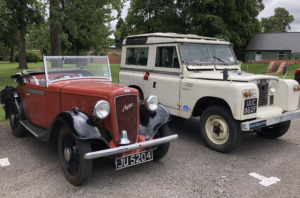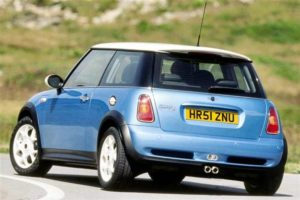The question of what the future holds for the classic car industry and its sizeable community is one that frequents many automotive businesses and enthusiasts. With the emergence of the electric vehicle and the now common-place conversion of classic vehicles to an electric powertrain, one is forced to contemplate how the classic car world might look in 15-20 years time as the principle ownership generation (60+ years of age) eventually fades and technological generations succeed. To a considerable extent, the future of the classic car community resides with the younger generation of today.
We spoke with Dave Withers, chief executive of StarterMotor Charity.
Starter Motor’s premise is putting the next generation in the driving seat, or more simply, “putting young people in old cars” as Withers put it. As the situation stands, based on observable trends, half of the UK’s 1 million classic cars will lack a driver within the next 10 years, stipulated by several transparent factors.

A 1934 Austin 10, part of StarterMotor’s fleet
Foremost, there persists a distinct lack of interest in classic motors amongst younger generations, based on several factors of its own. The days of children joining their fathers’ to self-service lovely old cars are now two generations behind us, replaced by perceptions of the motor car as a simple medium for getting from place ‘a’ to place ‘b’. The actual activity of ‘driving’ or ‘going for a drive’ is increasingly diluted as time goes by, to an extent that the verb ‘motoring’ is virtually non-existent. The visceral and raw classic driving experience, alongside the sentiments of a bustling motoring community, is very much lost on the emerging generation.
Similarly, the classic industry continues to be regarded an older-man’s world (no offence intended) plagued by perceptions of an insurmountable financial barrier to entry. As classics become rarer and rarer year on year, values (almost universally) appreciate in accordance, particularly due to involvement with the industry at investor level in the last decade. This is, however, more of a perceived problem than a problem in reality.

As time ticks by, new vehicles are pushed into the classic ‘bracket’, generally defined by a vehicle age of 20 years+, and as such, cars like the new-shape BMW ‘R50’ Mini Cooper of 2001 (which, by coincidence, are great drivers’ cars) are technically now eligible for ‘classic’ status. With these modern-classic vehicles routinely filling voids at the cheaper bottom-end of the classic spectrum, there remains an access point for younger generations to board the classic car ladder. As Withers pointed out, accessible ‘new’ classic vehicles play an important role in inspiring enthusiasm amongst the younger generations, serving as a stepping stone to the higher echelons of classic car ownership. Having said that, a certain snobbery still exists which stigmatises the entrance of new vehicles into the classic realm; something that has to change if interest levels are to inflate enough to substantiate the classic car community in decades to come.
It seems criminal that the classic car world, laden with mechanical gratification and community spirit, should soon be overlooked. But the exclusivity of classic car ownership, facilitated by rising prices and by certain community actors, perhaps most notably the single marque classic car clubs, are inadvertently stunting progress through no fault of their own. These sorts of clubs, although fantastic for their naturally constricted numbers of members, are by default entirely exclusive. They also have a tendency to compete with other single-marque clubs. Though this isn’t necessarily a problem today, there will almost certainly come a point in years to come where the survival of the classic community depends on universal inclusivity.
As Withers highlights, the sustenance of the classic world not only depends on interest and ownership levels, but also on the practical front of maintaining specialist vehicles which depend on historic engineering and highly refined skill sets; this is where StarterMotor specialises.
StarterMotor facilitates formal government-recognised apprenticeships within the historic vehicle sector, currently sponsoring 180 apprenticeships and overseeing 70 further students through the likes of the Silverstone UTC and the Heritage Skills Academy at Bicester Heritage. StarterMotor supports these courses through several means, including the physical provision of classic cars, both for students to work on and for students to drive and enjoy on the weekends; amongst many others, the StarterMotor fleet consists of a 1934 Austin 10 and a particularly special 1910 Oldsmobile curved dash, given and supported by the London to Brighton for use on the iconic rally. In addition to this, StarterMotor has a close working relationship with HERO ERA, as part of which apprentices drive and assess classic rallying vehicles (including E-Types, 911s, Delta Integrales and MGBs) around Bicester Heritage’s test track.
Enticing the younger generation to take on several years of specialist heritage training, such as trimming and coachworking, is at the forefront of necessary steps to sustain the classic car world. Even if we are to succeed in putting 50,000 new drivers in classic cars per year, their survival depends on the co-survival of specialist historic skills, which at some point will be entrusted on and wielded solely by the younger generations of today.
Ultimately, we can’t sustain 1 million+ classic cars within museums. Each and every one depends on an enthusiastic owner and a skilled individual capable of mechanically and cosmetically servicing it. It is the responsibility of the automotive businesses and enthusiasts of today to incept foundations capable of facilitating this reality down the line.
By Archie Forsyth.
—
It is our privilege at Mulsanne Automotive to support StarterMotor, and we look forward to working closely in the future.
